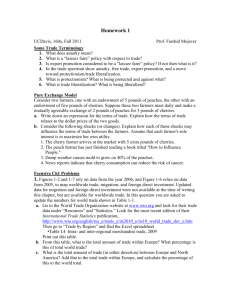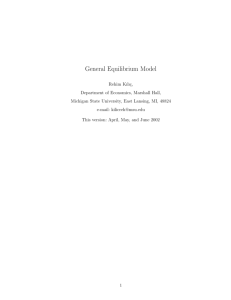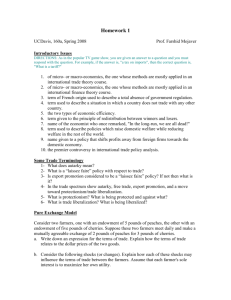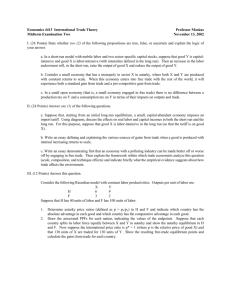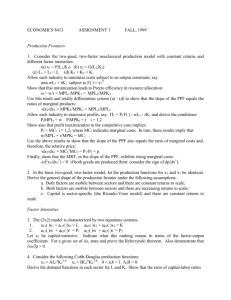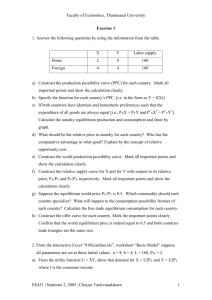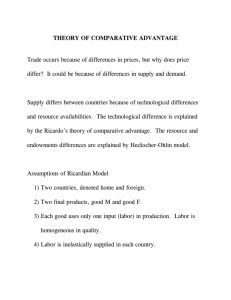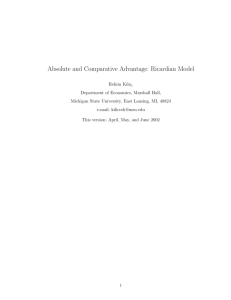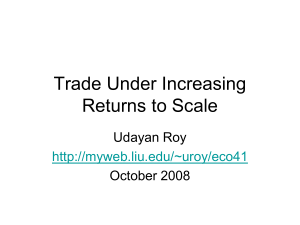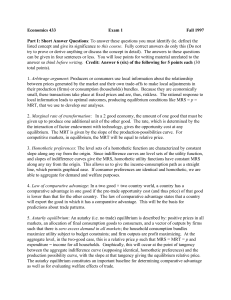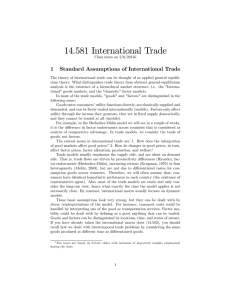Written Feedback HW1 1. With trade, domestic production will occur
advertisement
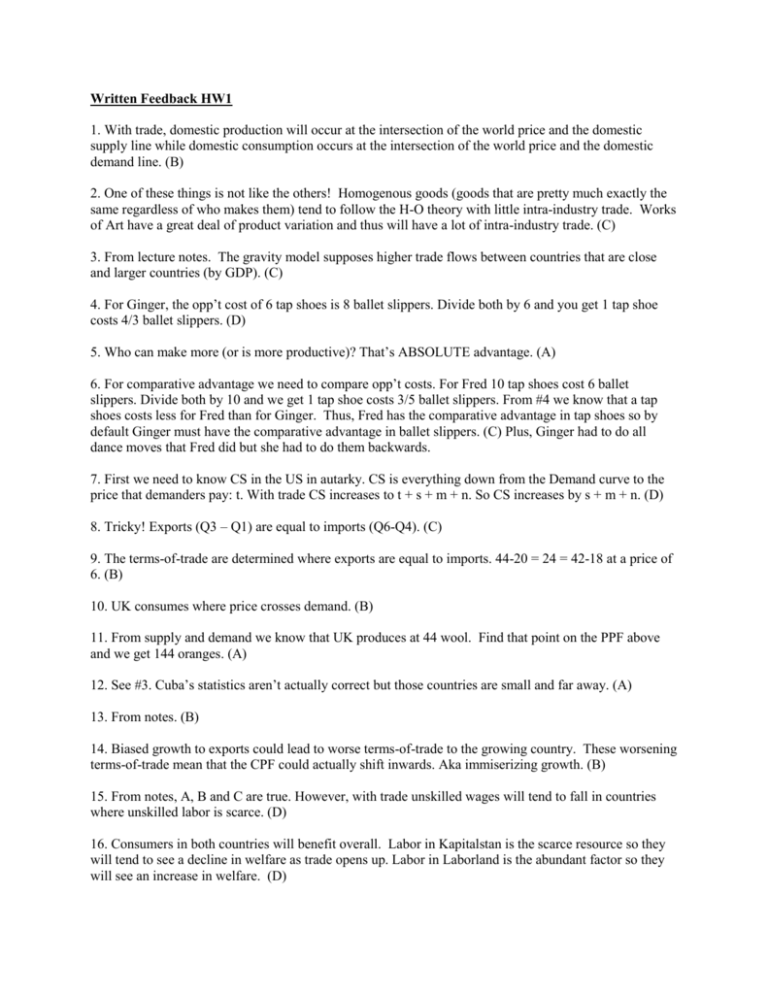
Written Feedback HW1 1. With trade, domestic production will occur at the intersection of the world price and the domestic supply line while domestic consumption occurs at the intersection of the world price and the domestic demand line. (B) 2. One of these things is not like the others! Homogenous goods (goods that are pretty much exactly the same regardless of who makes them) tend to follow the H-O theory with little intra-industry trade. Works of Art have a great deal of product variation and thus will have a lot of intra-industry trade. (C) 3. From lecture notes. The gravity model supposes higher trade flows between countries that are close and larger countries (by GDP). (C) 4. For Ginger, the opp’t cost of 6 tap shoes is 8 ballet slippers. Divide both by 6 and you get 1 tap shoe costs 4/3 ballet slippers. (D) 5. Who can make more (or is more productive)? That’s ABSOLUTE advantage. (A) 6. For comparative advantage we need to compare opp’t costs. For Fred 10 tap shoes cost 6 ballet slippers. Divide both by 10 and we get 1 tap shoe costs 3/5 ballet slippers. From #4 we know that a tap shoes costs less for Fred than for Ginger. Thus, Fred has the comparative advantage in tap shoes so by default Ginger must have the comparative advantage in ballet slippers. (C) Plus, Ginger had to do all dance moves that Fred did but she had to do them backwards. 7. First we need to know CS in the US in autarky. CS is everything down from the Demand curve to the price that demanders pay: t. With trade CS increases to t + s + m + n. So CS increases by s + m + n. (D) 8. Tricky! Exports (Q3 – Q1) are equal to imports (Q6-Q4). (C) 9. The terms-of-trade are determined where exports are equal to imports. 44-20 = 24 = 42-18 at a price of 6. (B) 10. UK consumes where price crosses demand. (B) 11. From supply and demand we know that UK produces at 44 wool. Find that point on the PPF above and we get 144 oranges. (A) 12. See #3. Cuba’s statistics aren’t actually correct but those countries are small and far away. (A) 13. From notes. (B) 14. Biased growth to exports could lead to worse terms-of-trade to the growing country. These worsening terms-of-trade mean that the CPF could actually shift inwards. Aka immiserizing growth. (B) 15. From notes, A, B and C are true. However, with trade unskilled wages will tend to fall in countries where unskilled labor is scarce. (D) 16. Consumers in both countries will benefit overall. Labor in Kapitalstan is the scarce resource so they will tend to see a decline in welfare as trade opens up. Labor in Laborland is the abundant factor so they will see an increase in welfare. (D) 17. Kapitalstan will export the capital intensive good: Food. Kapitalstan will import the labor intensive good: clothing. Kapital owners in Laborland are made worse off as they are the scarce industry. Arbitrage doesn’t happen if the countries are exactly the same (and we know they aren’t). (A) 18. From notes. H-O assumes different endowments of productive factors. (B) 19. Math time! MC of steak = 4r + 2w = 4(12) + 2(8) = 64. MC of potatoes = 4r + 4w = 4(12) + 4(8) = 80. (A) 20. Algebra! We know that 48 = 4r + 2w and 88 = 4r + 4w. 2 equations and 2 unknowns! (B) 21. Price of potatoes in Mexico in autarky is 80 and post-trade price rises to 88 so Mexico must be EXPORTING potatoes. Trade will be beneficial to both countries overall. Guatemala is importing potatoes and potatoes are labor intensive – so labor will see a decrease in returns (wages fall in Guatemala). (C) 22. Under free trade the CPF is represented by the line RC. The country is exporting good y and importing good x. Under free trade R is the production point and C is the consumption point. Under autarky the PPF is the CPF and the autarky consumption point is also the autarky production point. (B) 23. The country is exporting good y so they have a comparative advantage in good y. In autarky the country’s terms of trade are the slope of the PPF at point P (the slope of line P1). Moving from autarky to free trade means that productive factors employed in good x may lose their jobs, see declines in returns etc… so all of the above are true. (D) 24. Country A produces at point D and consumes at point C under free trade. So they produce x2 quantity of good x and consume x3 of good x. Exports must then be x2 – x3. (D) 25. Consumption and production in autarky are the same spot on the PPF. (C) 26. In trade, country A’s CPF is L1. B looks pretty good… In free trade, country A’s level of satisfaction is best represented by the indifference curve I2. (B) 27. Wait, where’s L1? L1 is country A’s CPF! But wait… both countries have the same terms-of-trade which means that the slope of L1 is equal to the slope of L3. (B) 28. Austria has higher productivity in chocolate bars so they have the absolute advantage in chocolate bars. For comparative advantage we need to look at opp’t costs. In Austria 1 leather jacket costs 9 chocolate bars while in Italy 1 leather jacket costs only 2 chocolate bars. So Italy must have the comparative advantage in leather jackets and Austria has a comparative advantage in chocolate bars. (C) 29. From notes. LARGE transportation costs are a reason for intra-industry trade. (B)
